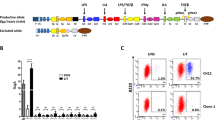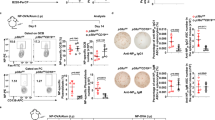Abstract
Class II transactivator (CIITA), a coactivator required for class II major histocompatibility complex (MHC) transcription, is expressed in B cells but extinguished in plasma cells. This report identifies B lymphocyte–induced maturation protein 1 (BLIMP-1), a transcriptional repressor that is capable of triggering plasma cell differentiation, as a developmentally regulated repressor of CIITA transcription. BLIMP-1 represses the B cell–specific promoter of the human gene that encodes CIITA (MHC2TA) in a binding site–dependent manner. Decreased CIITA correlates with increased BLIMP-1 during plasma cell differentiation in cultured cells. Ectopic expression of BLIMP-1 represses endogenous mRNA for CIITA and the CIITA targets, class II MHC, invariant chain and H2-DM (the murine equivalent of HLA-DM) in primary splenic B cells as well as 18-81 pre-B cells. Thus, the BLIMP-1 program of B cell differentiation includes loss of antigen presentation via extinction of CIITA expression.
This is a preview of subscription content, access via your institution
Access options
Subscribe to this journal
Receive 12 print issues and online access
$209.00 per year
only $17.42 per issue
Buy this article
- Purchase on Springer Link
- Instant access to full article PDF
Prices may be subject to local taxes which are calculated during checkout







Similar content being viewed by others
References
Ghosh, P., Amaya, M., Mellins, E. & Wiley, D. C. The structure of an intermediate in class II MHC maturation: CLIP bound to HLA-DR3. Nature 378, 457–462 (1995).
Fling, S. P., Arp, B. & Pious, D. HLA-DMA and -DMB genes are both required for MHC class II/peptide complex formation in antigen-presenting cells. Nature 368, 554–558 (1994).
Denzin, L. K. & Cresswell, P. HLA-DM induces CLIP dissociation from MHC class II αβ dimers and facilitates peptide loading. Cell 82, 155–165 (1995).
Sherman, M. A., Weber, D. A. & Jensen, P. E. DM enhances peptide binding to class II MHC by release of invariant chain-derived peptide. Immunity 3, 197–205 (1995).
Wilson, I. A. Another twist to MHC-peptide recognition. Science 272, 973–974 (1996).
Ting, J. P. -Y. & Baldwin, A. S. Regulation of MHC gene expression. Curr. Opin. Immunol. 5, 8–16 (1993).
Glimcher, L. H. & Kara, C. J. Sequences and factors: a guide to MHC class-II transcription. Ann. Rev. Immunol. 10, 13–49 (1992).
Lala, P. K., Johnson, G. T., Battye, F. C. & Nossal, G. T. Maturation of B-lymphocytes. Concurrent appearance of increasing Ig, Ia and mitogen responsiveness. J. Immunol. 122, 334–340 (1979).
Halper, J., Fu, S. M., Wang, C. -Y., Winchester, R. & Kunkel, H. G. Patterns of expression of “Ia-like” antigens during the terminal stages of B cell development. J. Immunol. 120, 1480–1484 (1978).
Miki, N. et al. Role of I-A molecules in early stages of B cell maturation. J. Immunol. 149, 801–807 (1992).
Burrows, P. D. & Cooper, M. D. Regulated expression of cell surface antigens during B cell development. Semin. Immunol. 2, 189–195 (1990).
Rosa, F. et al. Differential regulation of HLA-DR mRNAs and cell surface antigens by interferon. EMBO J. 2, 1585–1589 (1983).
Collins, T. et al. Immune interferon activates multiple class II major histocompatibility complex genes and the associated invariant chain gene in human endothelial cells and dermal fibroblasts. Proc. Natl Acad. Sci. USA 81, 4917–4921 (1984).
Benoist, C. & Mathis, D. Regulation of major histocompatibility complex class-II genes: X, Y, and other letters of the alphabet. Ann. Rev. Immunol. 8, 681–715 (1990).
Brown, A. M., Wright, K. L. & Ting, J. P. Human major histocompatibility complex class II-associated invariant chain gene promoter. Functional analysis and in vivo protein/DNA interactions of constitutive and IFN-γ-induced expression. J. Biol. Chem. 268, 26328–26333 (1993).
Ting, J. P. -Y., Wright, K. L., Chin, K. -C., Brickey, W. J. & Li, G. The DMB promoter: Delineation, in vivo footprint, trans-activation and transdominant-suppression. J. Immunol. 159, 5457–5462 (1997).
Steimle, V., Otten, L. A., Zufferey, M. & Mach, B. Complementation cloning of an MHC class II transactivator mutated in hereditary MHC class II deficiency (or bare lymphocyte syndrome). Cell 75, 135–146 (1993).
Chang, C. H., Fontes, J. D., Peterlin, M. & Flavell, R. A. Class II transactivator (CIITA) is sufficient for the inducible expression of major histocompatibility complex class II genes. J. Exp. Med. 180, 1367–1374 (1994).
Harton, J. A. & Ting, J. P. Class II transactivator: mastering the art of major histocompatibility complex expression. Mol. Cell Biol. 17, 6185–6194 (2000).
Chang, C. -H., Guerder, S., Hong, S. -C., van Ewijk, W. & Flavell, R. A. Mice lacking the MHC class II transactivator (CIITA) show tissue-specific impairment of MHC class II expression. Immunity 4, 167–178 (1996).
Williams, G. S. Mice lacking the transcription factor CIITA -a second look. Int. Immunol. 10, 1957–1967 (1998).
Itoh-Lindstrom, Y. et al. Reduced IL-4, LPS, and IFN-γ induced MHC class II expression in mice lacking the GTP-binding domain of CIITA, class II transactivator. J. Immunol. 163, 2425–2431. (1999).
Kara, C. J. & Glimcher, L. H. Promoter accessibility within the environment of the MHC is affected in class II-deficient combined immunodeficiency. EMBO J. 12, 187–193 (1993).
Silacci, P., Mottet, A., Steimle, V., Reith, W. & Mach, B. Developmental extinction of major histocompatibility complex class II gene expression in plasmocytes is mediated by silencing of the transactivator gene CIITA. J. Exp. Med. 180, 1329–1336 (1994).
Chin, K. -C. et al. Molecular analysis of G1B and G3A IFN-γ mutants reveals that defects in CIITA or RFX result in defective class II MHC and Ii gene induction. Immunity 1, 687–697 (1994).
Sartoris, S., Tosi, G., De Lerma Barbaro, A., Cestari, T. & Accolla, R. S. Active suppression of the class II transactivator-encoding AIR-1 locus is responsible for the lack of major histocompatibility complex class II gene expression observed during differentiation from B cells to plasma cells. Eur. J. Immunol. 26, 2456–2460 (1996).
Muhlethaler-Mottet, A., Otten, L. A., Steimle, V. & Mach, B. Expression of MHC class II molecules in different cellular and functional compartments is controlled by differential usage of multiple promoters of the transactivator CIITA. EMBO J. 16, 2851–2860 (1997).
Lennon, A. M. et al. Isolation of a B-cell-specific promoter for the human class II transactivator. Immunogen 45, 266–273 (1997).
Piskurich, J. F., Wang, Y., Linhoff, M. W., White, L. C. & Ting, J. P. Identification of distinct regions of 5′ flanking DNA that mediate constitutive, IFN-γ, STAT1, and TGF-β-regulated expression of the class II transactivator gene. J. Immunol. 160, 233–240 (1998).
Ghosh, N. et al. Two novel sequence elements activate the MHC class II transactivator, CIITA, in B-lymphocytes. J. Biol. Chem. 274, 32342–32350 (1999).
Piskurich, J. F., Linhoff, M. W., Wang, Y. & Ting, J. P. Y. Two distinct γ interferon-inducible promoters of the major histocompatibility complex class II transactivator gene are differentially regulated by STAT1, interferon regulatory factor 1, and transforming growth factor β. Mol. Cell. Biol. 19, 431–440 (1999).
Nikcevich, K. M., Piskurich, J. F., Hellendall, R. P., Wang, Y. & Ting, J. Differential selectivity of the CIITA promoter activation by IFN-γ, TNF-α and IRF-1 in primary astrocytes and a macrophage cell line. J. Neuroimmunol. 99, 195–204 (1999).
Kakkis, E. & Calame, K. A plasmacytoma-specific factor binds the c-myc promoter region. Proc. Natl Acad. Sci. USA 84, 7031–7035 (1987).
Kakkis, E., Riggs, K. J., Gillespie, W. & Calame, K. A transcriptional repressor of c- myc. Nature 339, 718–721 (1989).
Turner, C. A. Jr, Mack, D. H. & Davis, M. M. Blimp-1, a novel zinc finger-containing protein that can drive the maturation of B lymphocytes into immunoglobulin-secreting cells. Cell 77, 297–306 (1994).
Lin, Y., Wong, K. & Calame, K. Repression of c- myc transcription by Blimp-1, an inducer of terminal B cell differentiation. Science 276, 596–599 (1997).
Randall, T. D. et al. Arrest of B lymphocyte terminal differentiation by CD40 signaling: mechanism for lack of antibody-secreting cells in germinal centers. Immunity 8, 733–742 (1998).
Tanaka, N., Kawakami, T. & Taniguchi, T. Recognition DNA sequences of interferon regulatory factor 1 (IRF-1) and IRF-2, regulators of cell growth and the interferon system. Mol. Cell. Biol. 13, 4531–4538 (1993).
Keller, A. D. & Maniatis, T. Identification and characterization of a novel repressor of β-interferon gene expression. Genes Dev. 5, 868–879 (1991).
Latron, F. et al. Active suppression of major histocompatibility complex class II gene expression during differentiation from B-cells to plasma cells. Proc. Natl Acad. Sci. USA 85, 2229–2233 (1988).
Dellabona, P., Latron, F., Maffei, A., Scarpellino, L. & Accolla, R. S. Transcriptional control of MHC class II gene expression during differentiation from B cells to plasma cells. J. Immunol. 142, 2902–2910 (1989).
Chang, C. H., Fodor, W. L. & Flavell, R. A. Reactivation of a major histocompatibility complex class II gene in mouse plasmacytoma cells and mouse T cells. J. Exp. Med. 176, 1465–1469 (1992).
Natkunam, Y., Zhang, X., Liu, Z. & Chen-Kiang, S. Simultaneous activation of Ig and Oct-2 synthesis and reduction of surface MHC class II expression by IL-6. J. Immunol. 153, 3476–3484 (1994).
Yu, J., Angelin-Duclos, C., Greenwood, J., Liao, J. & Calame, K. Transcriptional repression by blimp-1 (PRDI-BF1) involves recruitment of histone deacetylase. Mol. Cell. Biol. 20, 2592–2603 (2000).
Andersson, J., Bullock, W. W. & Melchers, F. Inhibition of mitogenic stimulation of mouse lymphocytes by anti-mouse immunoglobulin antibodies. I. Mode of action. Eur. J. Immunol. 4, 715–722 (1974).
Lee, Y. J. et al. TGF-β suppresses IFN-β induction of class II MHC gene expression by inhibiting class II transactivator messenger RNA expression. J. Immunol. 158, 2065–2075 (1997).
Nandan, D. & Reiner, N. E. TGF-β attenuates the class II transactivator and reveals an accessory pathway of IFN-β action. J. Immunol. 158, 1095–1101 (1997).
Ren, B., Chee, K. J., Kim, T. H. & Maniatis, T. PRDI-BF1/Blimp-1 repression is mediated by corepressors of the Groucho family of proteins. Genes Dev. 13, 125–137 (1999).
Lin, K.-I., Lin, Y. & Calame, K. Repression of c -myc is necessary but not sufficient for terminal differentiation of B lymphocytes in vitro. Mol. Cell. Biol. 20 (in the press, 2000).
Chang, D. H., Angelin-Duclos, C. & Calame, K. BLIMP-1: trigger for differentiation of myeloid lineage. Nature Immunol. 1, 169–176 (2000).
Angelin-Duclos, C. & Calame, K. Evidence that immunoglobulin VH-DJ recombination does not require germ line transcription of the recombining variable gene segment. Mol. Cell. Biol. 18, 6253–6264 (1998).
Burns, J. C., Friedmann, T., Driever, W., Burrascano, M. & Yee, J. K. Vesicular stomatitis virus G glycoprotein pseudotyped retroviral vectors: concentration to very high titer and efficient gene transfer into mammalian and nonmammalian cells. Proc. Natl Acad. Sci. USA 90, 8033–8037 (1993).
Acknowledgements
We thank S. Chen-Kiang for the system of in vitro B cell differentiation using IL-6. Supported by grants AI29564, AI41751, AI41580, NS34190 (to J. P. -Y. T.) and GM29361, AI43567 (to K. C.). J. F. P. is a postdoctoral fellow of the National Multiple Sclerosis Society (FG 1173-A-1 and FA 1374-A-2) and K. –I. L. is a fellow of the Leukemia and Lymphoma Society (5332-00).
Author information
Authors and Affiliations
Corresponding author
Rights and permissions
About this article
Cite this article
Piskurich, J., Lin, KI., Lin, Y. et al. BLIMP-1 mediates extinction of major histocompatibility class II transactivator expression in plasma cells. Nat Immunol 1, 526–532 (2000). https://doi.org/10.1038/82788
Received:
Accepted:
Issue Date:
DOI: https://doi.org/10.1038/82788
This article is cited by
-
The BLIMP1—EZH2 nexus in a non-Hodgkin lymphoma
Oncogene (2020)
-
Iguratimod represses B cell terminal differentiation linked with the inhibition of PKC/EGR1 axis
Arthritis Research & Therapy (2019)
-
Ufbp1 promotes plasma cell development and ER expansion by modulating distinct branches of UPR
Nature Communications (2019)
-
Circulating plasmablasts/plasma cells: a potential biomarker for IgG4-related disease
Arthritis Research & Therapy (2017)
-
Increased cathepsin S in Prdm1−/− dendritic cells alters the TFH cell repertoire and contributes to lupus
Nature Immunology (2017)



